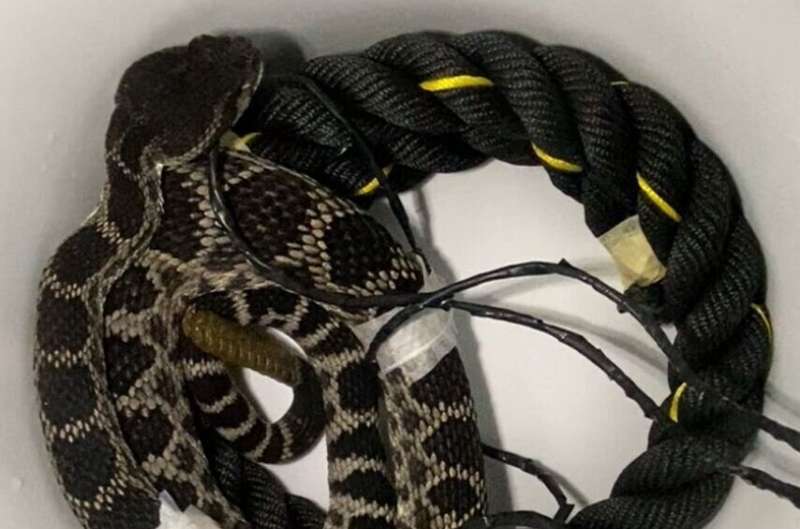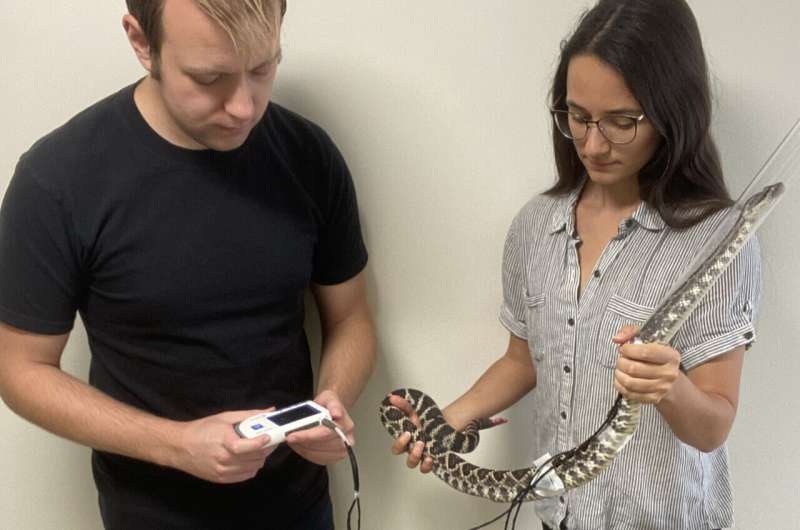This article has been reviewed according to Science X's editorial process and policies. Editors have highlighted the following attributes while ensuring the content's credibility:
fact-checked
trusted source
proofread
Stressed rattlesnakes found to calm down in the company of a nearby 'friend'

When a creature's stress levels decrease because of the presence of a companion, it is known as social buffering. In highly social animals, such as mammals and birds, this phenomenon is well studied. Now, researchers have examined social buffering in rattlesnakes and found that the presence of a second snake significantly reduced rattlesnakes' change in heart rates after they experienced disturbance. It is the first evidence of social buffering in reptiles.
When animals suffer from acute or chronic stress, they produce more hormones causing shifts in the nervous system, immune response, and behavior. Some animals, if they are in the presence of a conspecific, can modulate their response to buffer stress. This is known as social buffering.
There is some research suggesting that snakes can exhibit complex social behavior. Nevertheless, social buffering in reptiles, as well as in other asocial organisms and solitary foragers, hasn't been studied extensively. Now, researchers in the U.S. have examined if rattlesnakes inhabiting Southern California use social buffering to alleviate acute stress.
"We showed that when two snakes were together and experienced a stressful situation, they could buffer each other's stress response, much like what happens to humans when they endure a stressful event together," said Chelsea Martin, a Ph.D. student at Loma Linda University and first author of a new Frontiers in Ethology study. "This dampening of the stress response has not been reported previously in any reptile species."

Snakes that rattle buffer
When exposed to stress, the presence of a snake companion reduced the change in heart rate of snakes significantly. Because the researchers worked with wild-caught rattlesnakes, they could show that social buffering likely exists in nature and can persist in captivity.
"Our test snakes came from populations that overwinter individually and communally. We found no differences in snake populations who did or didn't overwinter in groups," Martin explained. "We also did not observe a difference in social buffering between the sexes."
Montane rattlesnakes hibernate communally, which could have been an indicator of stronger social networks than in lowland rattlesnakes, which usually overwinter alone. It is also known that female rattlesnakes aggregate during pregnancy and remain with newborn offspring. Testing for these variables helped the researchers establish that proclivity to buffer was equally pronounced in both populations as well as female and male snakes.
Snakes in a bucket
For their study, the researchers assessed social buffering in 25 wild-caught southern Pacific rattlesnakes in three scenarios: when the snakes were alone, in the presence of a rope that served as inanimate control object, and while the snakes were in the presence of a same-sex companion.
Measuring rattlesnakes' heart rates should be a reliable indicator of acute stress levels and social buffering. To obtain data, the researchers outfitted the snakes with electrodes near their hearts and attached the sensors to a heart rate monitor. They then placed the snakes in a bucket—a dark, enclosed testing environment.
After an adjustment period of 20 minutes, the snakes were artificially disturbed. Then Martin and the research team measured the snakes' heart rate increase from baseline, the time it took for their heart rate to return to normal, and the time they spent rattling.
An image boost for rattlesnakes
"Our results provide insights into social behavior patterns of snakes," said Martin. "But it might also improve rattlesnakes' image. In the public eye they are often maligned. Our findings could help to change that," she added.
The scientists also pointed to some limitations they worked with. During the experiment's duration, the snake pairs were kept in very confined spaces. Accordingly, they did not examine whether a stress buffering response occurs when snakes are close, but not in physical contact with each other. Another unknown variable, which the researchers hope to test in the future, is if familiarity between two snakes impacts their social buffering response.
More information: Social Security: Can rattlesnakes reduce acute stress through social buffering?, Frontiers in Ethology (2023). DOI: 10.3389/fetho.2023.1181774
Provided by Frontiers




















